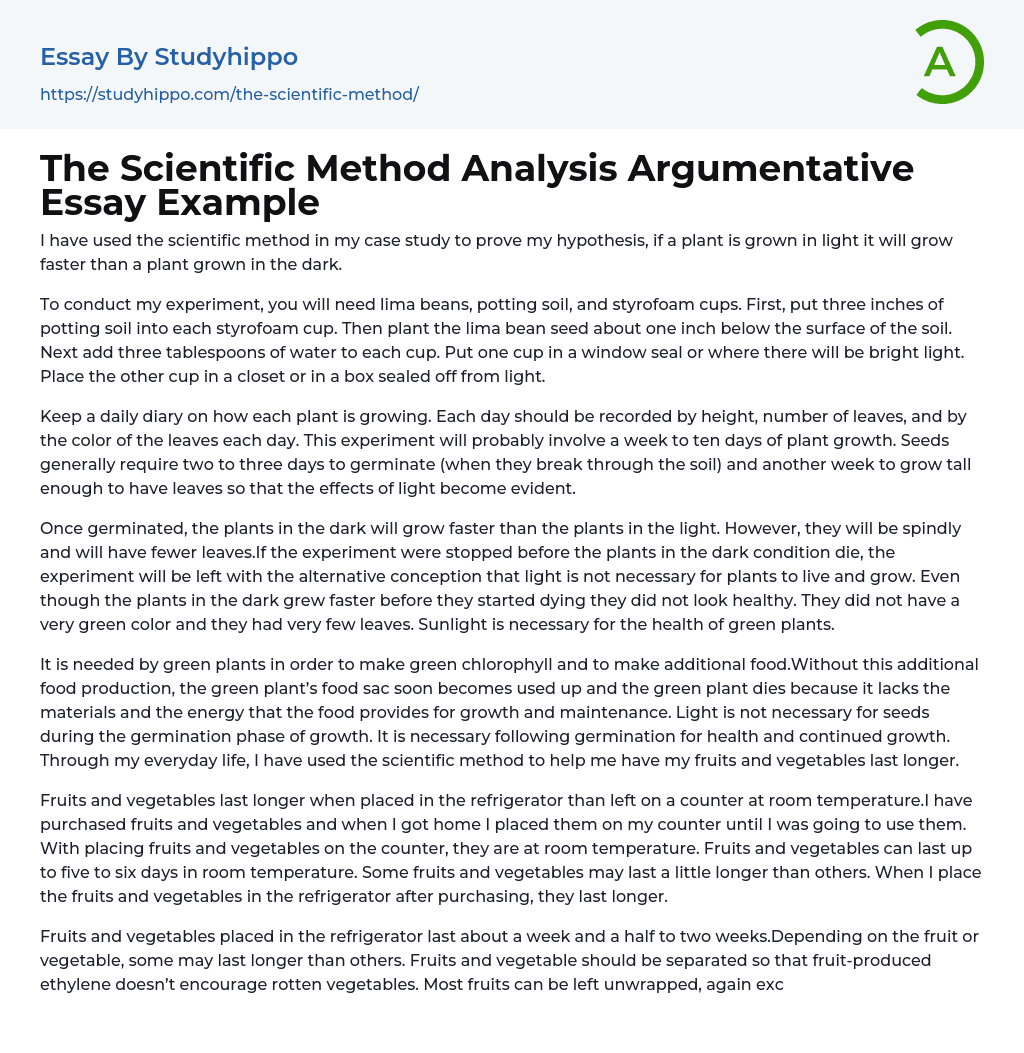

The Scientific Method Analysis Argumentative Essay Example
Using the scientific method, I have demonstrated that a plant will grow at a faster rate when exposed to light compared to when grown in darkness. To conduct this experiment, gather lima beans, potting soil, and styrofoam cups. Start by filling each cup with three inches of potting soil. Proceed to plant the lima bean seed approximately one inch below the soil's surface. Then, pour three tablespoons of water into each cup. Finally, position one cup in an illuminated spot such as a window sill.
To ensure the safety of a cup, it can be stored in a closet or sealed container. It is recommended to maintain a daily diary to monitor the progress of each plant, recording their height, leaf count, and color. This experiment is expected to span approximately one week to ten days. The germination process takes around two to three days, followed by another
...week for the plants to grow sufficiently for light effects to be evident. Once germinated, the plants kept in darkness will exhibit faster growth compared to those exposed to light.
Although plants grown in darkness may initially experience faster growth, they will ultimately become weak and have fewer leaves. If the experiment concludes before these plants perish, it will indicate that light is not essential for plant survival and growth. However, despite their accelerated growth, dark-grown plants were unhealthy, lacking a vibrant green hue and having a limited leaf count. Sunlight plays a vital role in maintaining the health of green plants by facilitating chlorophyll production and generating additional nourishment. Without this extra food production, a green plant's resources quickly deplete, leading to its demise due to insufficient materials
and energy for growth and maintenance. Nonetheless, during the germination stage of seed development, light is unnecessary.
After germination, it is crucial to ensure the health and growth of fruits and vegetables. In my daily routine, I effectively utilize the scientific method to improve the longevity of my produce. Normally, I keep newly bought fruits and vegetables on the countertop until they become perfectly ripe for eating. However, refrigeration considerably extends their freshness as compared to storing them at room temperature.
At room temperature, fruits and vegetables can stay fresh for approximately five to six days, although certain types may endure slightly longer. However, refrigerating them after purchase can prolong their freshness for one and a half to two weeks. It is important to note that each produce item has its own lifespan. To prevent early spoilage of vegetables, it is recommended to store them separately from fruits because the ethylene gas released by fruits can speed up decay.
Most fruits, excluding delicate items like peaches and berries, can be left unwrapped. To extend the crispness of vegetables, use sealed plastic bags. Leafy vegetables like spinach and lettuce can benefit from being wrapped in a dry paper towel to absorb moisture and prolong their freshness. If root vegetables will not be used within three days, it is recommended to trim their leafy tops to prevent loss of moisture from the roots.
The scientific method is founded on the concept of cause and effect. Experimentation, a crucial component of a robust scientific method, aims to test hypotheses. The scientific method encompasses various techniques for investigating phenomena, acquiring new knowledge, and refining or integrating existing knowledge. It relies on gathering observable,
empirical, and measurable evidence guided by specific principles of reasoning.
Scientific methodology involves gathering data through observation and experimentation, as well as formulating and testing hypotheses. While procedures may differ between different fields of study, identifiable features separate scientific inquiry from other methods of gaining knowledge. Scientists propose hypotheses to explain phenomena and conduct experimental studies to test them. It is vital for these steps to be repeatable to reliably predict future results.
Theories that encompass broader areas of study can connect multiple hypotheses in a cohesive structure, aiding in the development of new hypotheses and providing context for groups of hypotheses. One important aspect shared by various fields of study is the requirement for objectivity to minimize biased interpretations of results. Additionally, it is expected that all data and methodology be documented, archived, and shared so that other scientists can carefully examine them and attempt to reproduce the results. This practice, known as full disclosure, also allows for the establishment of statistical measures of data reliability.
References:
- Axia College of University of Phoenix. (2008) Retrieved July 24, 2008, from Axia College,
- Appendix B reading, aXcess, SCI 230-
- Introduction to Life Science Denise Balkissoon, Washing and Storing Your Fruits and Vegetables Dennis W. Sunal, Sunlight and Plants
- The University of Alabama Wikipedia, http://en.wikipedia.org/wiki/Scientific_method
- Tree essays
- Seed essays
- Experiment essays
- Explorer essays
- Hypothesis essays
- Observation essays
- Qualitative Research essays
- Research Methods essays
- Theory essays
- Bacteria essays
- Biotechnology essays
- Breeding essays
- Cell essays
- Cell Membrane essays
- Cystic Fibrosis essays
- Enzyme essays
- Human essays
- Microbiology essays
- Natural Selection essays
- Photosynthesis essays
- Plant essays
- Protein essays
- Stem Cell essays
- Viruses essays



